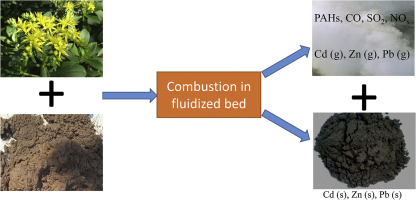Journal of Cleaner Production ( IF 9.7 ) Pub Date : 2018-01-18 , DOI: 10.1016/j.jclepro.2018.01.105 Feihong Guo , Zhaoping Zhong

|
The co-combustion of sedum plumbizincicola and sludge is becoming increasingly popular due to its environmental and economic benefits. Here, combustion experiments are performed in a large-scale fluidized bed at different temperatures. Results show that in flue gas, CO and NOx exceed the emission standard and should be controlled by denitrification system before discharge. Three-ring polycyclic aromatic hydrocarbons (PAHs) are found to be the major organic pollutants, but no six-ring PAH is detected in the combustion process. The emission concentrations of Cd, Zn, and Pb are below the standard. With increased temperature from 700 °C to 1000 °C, the concentrations of total PAHs, NOx, and Zn increase. The proportion of residual fraction in Cd for bottom ash increases from 16.82% to 44.03%. The proportion of exchangeable and carbonate-associated fractions in fly ash increases from 15.18% to 19.78%. The dominant phase in Zn and Pb is the residual fraction. With increased temperature, the leaching rates of Cd, Zn and Pb increase with different extents. Leaching rates in fly ash are less than those in bottom ash (except for Cd at 900 and 1000 °C). Cd and Zn show medium risk to environment in fly ash and bottom ash. Pb presents no risk to the ecosystem in fly ash and low risk in bottom ash. The co-combustion is suitable for the disposal of S. plumbizincicola and sludge in China.











































 京公网安备 11010802027423号
京公网安备 11010802027423号